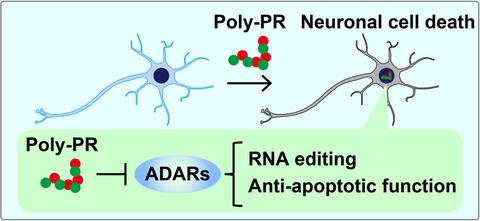当前位置:
X-MOL 学术
›
J. Neurochem.
›
论文详情
Our official English website, www.x-mol.net, welcomes your
feedback! (Note: you will need to create a separate account there.)
Proline-arginine poly-dipeptide encoded by the C9orf72 repeat expansion inhibits adenosine deaminase acting on RNA
Journal of Neurochemistry ( IF 4.2 ) Pub Date : 2021-06-03 , DOI: 10.1111/jnc.15445 Hiroaki Suzuki 1 , Masaaki Matsuoka 1
Journal of Neurochemistry ( IF 4.2 ) Pub Date : 2021-06-03 , DOI: 10.1111/jnc.15445 Hiroaki Suzuki 1 , Masaaki Matsuoka 1
Affiliation

|
A GGGGCC hexanucleotide repeat expansion in the C9orf72 gene is linked to the pathogenesis of amyotrophic lateral sclerosis (ALS) and frontotemporal dementia (FTD) (C9-ALS/FTD). Unconventional translation of the hexanucleotide repeat expansion generates five dipeptide repeat proteins (DPRs). The molecular mechanism underlying the DPR-linked neurotoxicity is under investigation. In this study, using cell-based models, we show that poly-proline-arginine DPR (poly-PR), the most neurotoxic DPR in vitro, binds to adenosine deaminase acting on RNA (ADAR)1p110 and ADAR2 and inhibits their RNA editing activity. We further show that poly-PR impairs cellular stress response that is mediated by ADAR1p110. These results together suggest that the poly-PR-mediated inhibition of the ADAR activity contributes to C9-ALS/FTD-linked neurotoxicity.
中文翻译:

C9orf72 重复扩增编码的脯氨酸-精氨酸聚二肽抑制作用于 RNA 的腺苷脱氨酶
一个六核苷酸GGGGCC重复扩张在C9orf72基因与肌萎缩侧索硬化 (ALS) 和额颞叶痴呆 (FTD) (C9-ALS/FTD) 的发病机制有关。六核苷酸重复扩增的非常规翻译产生五个二肽重复蛋白 (DPR)。DPR 相关神经毒性的分子机制正在研究中。在这项研究中,我们使用基于细胞的模型,表明聚脯氨酸-精氨酸 DPR (poly-PR),体外最具神经毒性的 DPR,与作用于 RNA (ADAR)1p110 和 ADAR2 的腺苷脱氨酶结合并抑制它们的 RNA 编辑活动。我们进一步表明,poly-PR 会损害由 ADAR1p110 介导的细胞应激反应。这些结果共同表明,聚 PR 介导的 ADAR 活性抑制有助于 C9-ALS/FTD 相关的神经毒性。
更新日期:2021-08-12
中文翻译:

C9orf72 重复扩增编码的脯氨酸-精氨酸聚二肽抑制作用于 RNA 的腺苷脱氨酶
一个六核苷酸GGGGCC重复扩张在C9orf72基因与肌萎缩侧索硬化 (ALS) 和额颞叶痴呆 (FTD) (C9-ALS/FTD) 的发病机制有关。六核苷酸重复扩增的非常规翻译产生五个二肽重复蛋白 (DPR)。DPR 相关神经毒性的分子机制正在研究中。在这项研究中,我们使用基于细胞的模型,表明聚脯氨酸-精氨酸 DPR (poly-PR),体外最具神经毒性的 DPR,与作用于 RNA (ADAR)1p110 和 ADAR2 的腺苷脱氨酶结合并抑制它们的 RNA 编辑活动。我们进一步表明,poly-PR 会损害由 ADAR1p110 介导的细胞应激反应。这些结果共同表明,聚 PR 介导的 ADAR 活性抑制有助于 C9-ALS/FTD 相关的神经毒性。











































 京公网安备 11010802027423号
京公网安备 11010802027423号